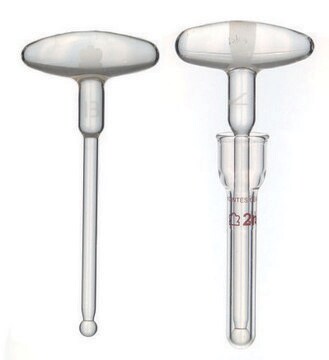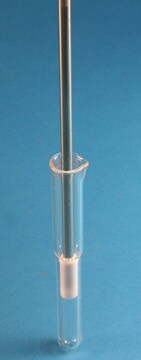P0610
Dounce tissue grinder pestle
Large clearance, working volume 7 mL
Synonym(s):
885301-0007
Sign Into View Organizational & Contract Pricing
All Photos(1)
About This Item
UNSPSC Code:
41121800
eCl@ss:
32080115
NACRES:
NB.22
Recommended Products
material
glass
working volume
7 mL
Looking for similar products? Visit Product Comparison Guide
General description
Designed primarily for cellular work where the nucleus remains intact after homogenization.
Features and Benefits
• Manufactured from borosilicate glass 3.3• Designed primarily for cellular work where the nucleus remains intact after homogenization.• All-glass construction• Two pestles are supplied with each complete unit• Large clearance pestle is used for the initial sample reduction• Small clearance pestle is used to form the final homogenate• Replacement components are available and completely interchangeable
Choose from one of the most recent versions:
Certificates of Analysis (COA)
Lot/Batch Number
Sorry, we don't have COAs for this product available online at this time.
If you need assistance, please contact Customer Support.
Already Own This Product?
Find documentation for the products that you have recently purchased in the Document Library.
Customers Also Viewed
Yuezhou Wang et al.
Cell chemical biology, 27(11), 1359-1370 (2020-07-11)
Multidrug resistance (MDR) in cancer remains a major challenge for the success of chemotherapy. Natural products have been a rich source for the discovery of drugs against MDR cancers. Here, we applied high-throughput cytotoxicity screening of an in-house natural product
Yue Zong et al.
Cell research, 29(6), 460-473 (2019-04-06)
AMPK, a master regulator of metabolic homeostasis, is activated by both AMP-dependent and AMP-independent mechanisms. The conditions under which these different mechanisms operate, and their biological implications are unclear. Here, we show that, depending on the degree of elevation of
Mengqi Li et al.
Cell metabolism, 30(3), 508-524 (2019-06-18)
Fructose-1,6-bisphosphate (FBP) aldolase links sensing of declining glucose availability to AMPK activation via the lysosomal pathway. However, how aldolase transmits lack of occupancy by FBP to AMPK activation remains unclear. Here, we show that FBP-unoccupied aldolase interacts with and inhibits
Our team of scientists has experience in all areas of research including Life Science, Material Science, Chemical Synthesis, Chromatography, Analytical and many others.
Contact Technical Service






